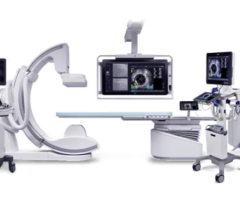
April 9, 2015 — Nearly half of interventional cardiologists responding to a survey conducted by the Society for Cardiovascular Angiography and Interventions (SCAI) reported at least one work-related orthopedic complication. The findings, published in Catheterization and Cardiovascular Interventions, indicate that occupational health issues are on the rise among interventional cardiologists.
A total of 314 interventional cardiologists responded to the email survey fielded in the fall of 2014. The survey focused on orthopedic injuries to the spine, hips, knees and ankle, as well as radiation-associated problems including cataracts and cancers.
“The results of the SCAI survey highlight the unique health risks that interventional cardiologists and cath lab staff face as they diagnose and treat cardiovascular disease,” said Lloyd W. Klein, M.D., FSCAI, lead author of the paper and professor of medicine at Rush Medical College in Chicago. “Most concerning is the fact that these risks have increased since interventional cardiologists were last surveyed in 2004. The health and safety of our patients is always our top priority, but these findings point to a very real need to address workplace safety for interventional cardiologists and cath lab staff.”
The survey found at least one orthopedic injury in 49 percent of practicing interventional cardiologist respondents, a finding that significantly correlated with age and was associated with annual case volume. A total of 6.9 percent of operators indicated they have had to limit the number of procedures they perform due to radiation exposure, and 9.3 percent have taken a health-related period of absence. The incidence of radiation-related conditions—including skin injuries, cataracts and hematologic and cancerous diseases—all were within the 5 percent range.
“Interventional practice has changed over the last decade,” said Klein. “Case volume and complexity, as well as procedural time and radiation exposure, have increased. While technologies to safeguard operators from radiation exposure have emerged, their adoption has been limited to lightweight lead aprons and low-dose imaging systems.”
Though SCAI and other societies emphasize compliance with personal dosimeter use, the survey suggests less than optimal use. Among respondents, 18.5 percent of respondents reported occasionally failing to wear a badge and 28.6 percent said they never wore one. Less has been accomplished to protect interventional cardiologists from work-related orthopedic issues associated with wearing protective attire.
Work-related absences have decreased since 2004, suggesting that interventional cardiologists continue working despite injuries.
“While awareness of cath lab safety is increasing, there is still a sizable opportunity to reduce the risks associated with delivering interventional therapies,” said SCAI 2014-15 President Charles Chambers, M.D., FSCAI. “The keys to success will include continuing to develop safer equipment and shields, and educating operators and their staff to consistently practice occupational safety.”
For more information: www.scai.org


 December 20, 2023
December 20, 2023 








